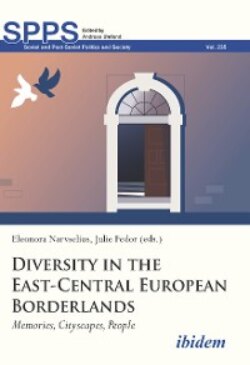Читать книгу Diversity in the East-Central European Borderlands - Группа авторов - Страница 29
На сайте Литреса книга снята с продажи.
Wrocław in Postwar Polish Socialist Period
ОглавлениеPoland took over the city in 1945 and renamed it Wrocław. The transfer was legitimized by the medieval connections with Poland and the myth of the Piast dynasty of Wrocław. The idea was that Poland had returned to its original location and “recovered its lost territories.”
The expulsion of twelve million Germans living east of Oder-Neisse and in Sudetenland was one of the largest ethnic cleansings in history.87 Poles immigrated, many of them having been expelled in their turn from regions ceded to the Soviet Union. Significant groups of Polish academics and intelligentsia arrived from the Lwów region. Numerous newcomers settled around Blücherstraße and Moltkestraße, a district that had previously been populated by many local Poles.88
It was general policy to erase German heritage and instead highlight the remains of the old, Slavic heritage, for example by restoring the medieval, “Bohemian” or “Polish” façades of buildings that in the seventeenth century were refurbished with “Austrian” or “German” baroque façades (cf. Netsch and Greiner 2012). German street names, memorials, symbols, and inscriptions were replaced by new ones, representing either Polish culture or socialism.89 Nazi victims were commemorated without special attention to the Jewish atrocities. In 1954–68 most remaining German cemeteries were dismantled, but one of them and two Jewish graveyards have remained (Thum 2011: 244–87). In 1945–49, many Polish Holocaust survivors settled in the region. In 1946 Lower Silesia had 90,000 Jews, without ties to the earlier Jewish communities. Due to the anti-Semitic campaign in 1968, most remaining Jews emigrated (Davies and Moorhouse 2003: 438 ff).
Architectural transformations proceeded in parallel with the societal changes. Lutheran churches were converted into Roman-Catholic ones, with the exception of Court Church at Kazimierza Street, which was taken over by Polish Protestants. In 1952, new Polish chapters in Wrocław and Opole (Oppeln) replaced the former German ones.
An extensive Soviet looting of the city hampered reconstruction of Wrocław. So too did the actions of the Polish authorities, who sent thousands of tons of brick-stones from the ruins for the reconstruction of Warsaw. New apartments were constructed, but old ones were insufficiently maintained. In 1951–58, 28,000 new dwellings were built or renovated, but 27,000 were lost through deterioration (Thum 2011: 135).
After infrastructure and several factories and administration buildings had been repaired, restoration of historical buildings began (ibid.: 244–87). Ruins and rubble were cleaned up before the prestigious Exhibition of the “Recovered Territories” in 1948 at the Centennial Hall, now renamed “People’s Hall.” It hosted an International Congress of Intellectuals in Defense of Peace with participants such as Graham Greene, Pablo Picasso, Salvatore Quasimodo, and Bertolt Brecht (Davies and Moorhouse 2003: 448).
It was only after 1953 that rebuilding of the city really took off. Priority was given to the city center, with reconstruction of the most important Old Town streets and squares. By the 1960s, old buildings at Rynek (Ringplatz) and Solny Square (Blücher-Platz) had been reconstructed, as well as most churches and monasteries, the armory, parts of the ramparts, and several other medieval buildings. This was in fact preservation of German heritage.90 Frequently, restoration was limited to the façade, with modest apartments behind. Some restored façades were given a more original look than existed before the war.91
In the early 1950s two monumental “socialist realist” buildings were constructed for the Polytechnic University at Plac Grunwaldzki (Kaiserstraße). They referred to Max Berg’s project from 1913, but in a more symmetrical and neo-classical form. The project was continued with modernist buildings.92
Comparisons of the urban plans expose gradually changing planning ideologies. A 1952 program stipulated restoration of all churches and palaces, several other monumental buildings, and many old merchant and residential buildings along the streets (Małachowicz 1976: 119). It aimed to restore a system of historical streets and squares (Rynek, Plac Solny, and Nowy Targ as well as the Świdnicka, Wita Stwosza, Świątej Katarzyny, Piaskowa, Świątej Jadwigi, and Katedralna Streets) and to adapt new buildings to the old environment while enabling scenic walks along the historical streets.
The city plans from 1949 and 1955, but not the program from 1952, included a new, and later implemented wide street along the former inner ramparts, replacing earlier malls and passages.93 The 1949 plan proposed to reconstruct the whole moat surrounding the Old Town, but the 1955 plan left it at status quo. Outside the moats, the 1949 plan proposed a large motor ring road and a modernist urban layout. The 1955 plan changed this to a more classic city layout, reconstructing urban streets and spaces, including Plac Kościuszko (Tauentzien-Platz). More traditional streets replaced the broad motor road.
“Socialist Realism” implied harmonizing new façades with old ones. The shift to modernism reduced the historical considerations. The planned historical reconstruction of Nowy Targ was replaced by modern blocks in 1961–65.94 This followed a plan from 1960 showing an extended ring street along the former inner ramparts, leaving the eastern part of the Old Town generally open with freestanding buildings, without traditional street spaces. The 1960 plan proposed a motor road crossing the Odra islands very close to the old “Sand” church and the former university library. A plan from 1968 shows a modernist urban concept on the empty grounds to the east.
Generally, Wrocław is an example of impressive resurrection from the ruins of the war and the reconstruction of one of Europe’s most beautiful urban centers. Modernist buildings from the interwar years, such as the Wertheim and Petersdorf stores, have also been brilliantly restored, and the Centennial Hall has been improved.95
